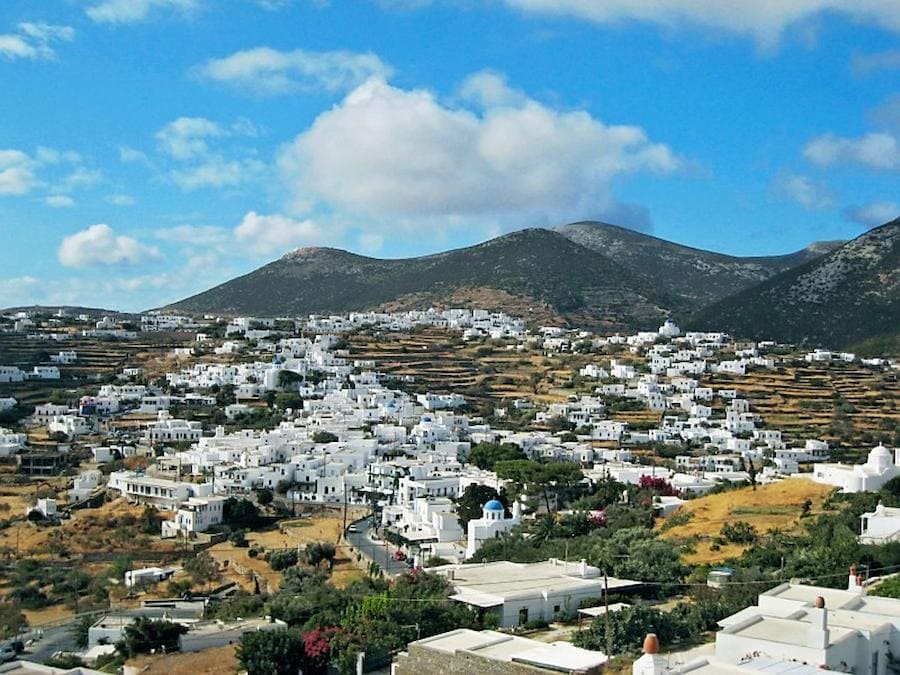Sifnos, a picturesque island in the Cyclades, captivates visitors with its rich history, beautiful landscapes, and culinary heritage. Known as the “island of flavours,” Sifnos combines traditional Greek charm with an elegant, laid-back ambience that appeals to travellers seeking both relaxation and cultural immersion. Its whitewashed villages, narrow cobbled streets, and iconic blue-domed churches create a postcard-perfect setting. Sifnos has a reputation for its vibrant arts and crafts, particularly pottery, which has been a local speciality for centuries.
The island’s Chora, Apollonia, is a lively town full of charming boutiques, cosy cafes, and traditional tavernas. Nearby, the village of Kastro, perched on a hill with dramatic sea views, offers a peek into the island’s medieval past, with stone-paved streets, ancient ruins, and small chapels dotting the landscape. Sifnos’s coastline is dotted with sandy beaches like Platis Gialos, Vathi, and Faros, each offering a peaceful retreat with crystal-clear waters perfect for swimming and sunbathing.
Gastronomy on Sifnos
Sifnos is renowned for its gastronomic traditions, which are deeply ingrained in the local culture. The island is the birthplace of Nikolaos Tselementes, Greece’s most famous chef and cookbook author, whose influence helped shape modern Greek cuisine. Sifnos’s culinary heritage is celebrated through simple, hearty dishes made with fresh, local ingredients and prepared in traditional clay pots.
One of the island’s most famous dishes is revithada, a chickpea stew that is slow-cooked overnight in a wood-fired oven, yielding tender, flavorful chickpeas with a rich, earthy taste. Mastelo, a local lamb or goat dish marinated in wine and herbs and baked with fennel, is another must-try specialty, perfect for meat lovers seeking authentic Cycladic flavors. Sifnos is also famous for its honey-drenched sweets like amygdalota (almond cookies) and loukoumades (honey-dipped doughnuts), which are often served at local celebrations and festivals.
Sifnos’s culinary offerings extend beyond tavernas to include unique pastry shops and family-run bakeries where visitors can sample homemade pies and desserts that showcase the island’s flavours. For those who enjoy exploring local gastronomy, Sifnos offers cooking classes and food tours, where guests can learn traditional recipes and culinary techniques passed down through generations.
Food Culture
Every social event on Sifnos but also every season maintains its typical flavours:
Sundays Sifnos’ meals the main dish is revithada, which is baked in clay rye (the skepastaria) for many hours, the previous night, in a wood-fired oven with the addition of onions, rainwater, and local aromatic herbs.
During the traditional festivals, the communal dinners reminiscent of the ancient meals everyone is offered the classical revithada and braised meat with pasta, cooked in special large cauldrons, or during Lent time, fried cod with skordalia always accompanied by a salad.
At Christmas time, on the other hand, all houses scent the traditional melomakarona and the avgokalamara, a local type of diples, while in the farmhouses or haystacks of rural families, singlino and pihti cheese.
Later, on Halloween, the housewives prepare dairy desserts, rice pudding (rizogalo), cream, or yogurt from goat or sheep milk, which is produced in large quantities at that time of year.
There is no Easter in Sifnos without the smell of the mastelo, (lamb or goat cooked in the special utensil also called mastelo), with red wine and flavoured with dill in a wood-burning oven, without the “birds of Easter” a kind of bread in the shape of birds, or the honey pie made from local anthotiro and thyme honey.
The joy of a wedding, again, is accompanied by the Sifnos’ pasteli, in a diamond shape.
Also traditional are the chickpea meatballs, the caper salad, the manouri (yellow, hard spicy cheese that ages in the in red wine lees), mizithra, dried figs, the “loli” a dessert made of red pumpkin, spoon sweet, and liqueurs from local fruits as well as infusions made of sage, mallow, and the couch grass.
Aside from agriculture, the island is known for its weaving and ceramics, an art that has thrived for over three centuries and which produces special cookware used for chickpea stews and lamb mastelo slowly cooked in red wine over vines.




